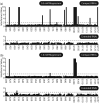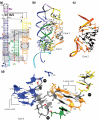Multiple metal-binding cores are required for metalloregulation by M-box riboswitch RNAs
- PMID: 19619558
- PMCID: PMC2755058
- DOI: 10.1016/j.jmb.2009.07.033
Multiple metal-binding cores are required for metalloregulation by M-box riboswitch RNAs
Abstract
Riboswitches are regulatory RNAs that control downstream gene expression in response to direct association with intracellular metabolites or metals. Typically, riboswitch aptamer domains bind to a single small-molecule metabolite. In contrast, an X-ray crystallographic structural model for the M-box riboswitch aptamer revealed the absence of an organic metabolite ligand but the presence of at least six tightly associated magnesiums. This observation agrees well with the proposed role of the M-box riboswitch in functioning as a sensor of intracellular magnesium, although additional nonspecific metal interactions are also undoubtedly required for these purposes. To gain greater functional insight into the metalloregulatory capabilities of M-box RNAs, we sought to determine whether all or a subset of the RNA-chelated magnesium ions were required for riboswitch function. To accomplish this task, each magnesium-binding site was simultaneously yet individually perturbed through random incorporation of phosphorothioate nucleotide analogues, and RNA molecules were investigated for their ability to fold in varying levels of magnesium. These data revealed that all of the magnesium ions observed in the structural model are important for magnesium-dependent tertiary structure formation. Additionally, these functional data revealed a new core of potential metal-binding sites that are likely to assist formation of key tertiary interactions and were previously unobserved in the structural model. It is clear from these data that M-box RNAs require specific binding of a network of metal ions for partial fulfillment of their metalloregulatory functions.
Figures





Similar articles
-
Insights into metalloregulation by M-box riboswitch RNAs via structural analysis of manganese-bound complexes.J Mol Biol. 2011 Apr 8;407(4):556-70. doi: 10.1016/j.jmb.2011.01.049. Epub 2011 Feb 15. J Mol Biol. 2011. PMID: 21315082 Free PMC article.
-
Modulation of quaternary structure and enhancement of ligand binding by the K-turn of tandem glycine riboswitches.RNA. 2013 Feb;19(2):167-76. doi: 10.1261/rna.036269.112. Epub 2012 Dec 17. RNA. 2013. PMID: 23249744 Free PMC article.
-
Effect of Sequence on the Interactions of Divalent Cations with M-Box Riboswitches from Mycobacterium tuberculosis and Bacillus subtilis.Biochemistry. 2021 Sep 21;60(37):2781-2794. doi: 10.1021/acs.biochem.1c00371. Epub 2021 Sep 2. Biochemistry. 2021. PMID: 34472844
-
Structural studies of the purine and SAM binding riboswitches.Cold Spring Harb Symp Quant Biol. 2006;71:259-68. doi: 10.1101/sqb.2006.71.015. Cold Spring Harb Symp Quant Biol. 2006. PMID: 17381305 Review.
-
An evolving tale of two interacting RNAs-themes and variations of the T-box riboswitch mechanism.IUBMB Life. 2019 Aug;71(8):1167-1180. doi: 10.1002/iub.2098. Epub 2019 Jun 17. IUBMB Life. 2019. PMID: 31206978 Free PMC article. Review.
Cited by
-
Metal ions: supporting actors in the playbook of small ribozymes.Met Ions Life Sci. 2011;9:175-96. doi: 10.1039/9781849732512-00175. Met Ions Life Sci. 2011. PMID: 22010272 Free PMC article. Review.
-
Force Field for Mg(2+), Mn(2+), Zn(2+), and Cd(2+) Ions That Have Balanced Interactions with Nucleic Acids.J Phys Chem B. 2015 Dec 17;119(50):15460-70. doi: 10.1021/acs.jpcb.5b10423. Epub 2015 Dec 3. J Phys Chem B. 2015. PMID: 26583536 Free PMC article.
-
The roles of metal ions in regulation by riboswitches.Met Ions Life Sci. 2011;9:141-73. doi: 10.1039/9781849732512-00141. Met Ions Life Sci. 2011. PMID: 22010271 Free PMC article. Review.
-
Thermodynamically stable RNA three-way junction for constructing multifunctional nanoparticles for delivery of therapeutics.Nat Nanotechnol. 2011 Sep 11;6(10):658-67. doi: 10.1038/nnano.2011.105. Nat Nanotechnol. 2011. PMID: 21909084 Free PMC article.
-
Insights into metalloregulation by M-box riboswitch RNAs via structural analysis of manganese-bound complexes.J Mol Biol. 2011 Apr 8;407(4):556-70. doi: 10.1016/j.jmb.2011.01.049. Epub 2011 Feb 15. J Mol Biol. 2011. PMID: 21315082 Free PMC article.
References
-
- Draper DE, Grilley D, Soto AM. Ions and RNA folding. Annu. Rev. Biophys. Biomol. 2005;34:221–243. - PubMed
-
- Woodson SA. Metal ions and RNA folding: a highly charged topic with a dynamic future. Curr. Opin. Chem. Biol. 2005;9:104–109. - PubMed
-
- Sigel RK, Pyle AM. Alternative roles for metal ions in enzyme catalysis and the implications for ribozyme chemistry. Chem. Rev. 2007;107:97–113. - PubMed
Publication types
MeSH terms
Substances
Grants and funding
LinkOut - more resources
Full Text Sources

